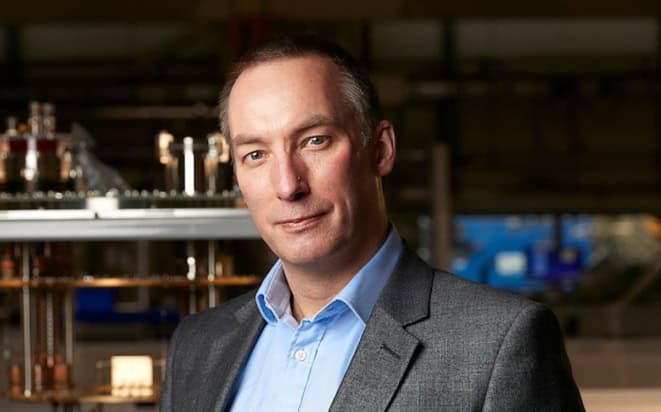

Colorado-based researchers have reduced the systematic uncertainty in their optical lattice clock to a record low. Ali Lezeik explains how they did it
New device is like an MRI machine for quantum materials, say physicists
Theoretical study proposes a "revolutionary" new method for constructing the future quantum Internet
 Read article: Quantum dot liquid scintillator could revolutionize neutrino detection
Read article: Quantum dot liquid scintillator could revolutionize neutrino detection
A new type of water-based scintillator made from quantum dots could make neutrino detectors safer and cheaper
 Read article: ‘Event-responsive’ electron microscopy focuses on fragile samples
Read article: ‘Event-responsive’ electron microscopy focuses on fragile samples
Pharmaceutical and catalysis research could benefit from new technique
 Read article: Sound waves move objects in liquid
Read article: Sound waves move objects in liquid
New technique might be used in applications such as targeted drug delivery, micro-robotics and even additive manufacturing
 Read article: How do electromagnetic waves carry information about objects they interact with?
Read article: How do electromagnetic waves carry information about objects they interact with?
Theorists develop new continuity equation to help them visualize the process
 Read article: Structured electrons have chiral mass and charge
Read article: Structured electrons have chiral mass and charge
Discovery has puzzled some physicists
 Read article: Matter-wave interferometry puts new limits on ‘chameleon particles’
Read article: Matter-wave interferometry puts new limits on ‘chameleon particles’
Gravity measurement benefits from optical lattice

Take a look inside our latest free-to-read Instrumentation and Vacuum Briefing. Covering the latest research updates, features and products, this issue highlights the role that “behind-the-scenes” technologies play in solving problems both in the lab and in the wider world outside it.
Join the audience for a live webinar on 18 September 2024 sponsored by BioLogic, in partnership with The Electrochemical Society
 Read article: Atomic clocks on the Moon could create ‘lunar positioning system’
Read article: Atomic clocks on the Moon could create ‘lunar positioning system’
Lunar time standard would avoid pitfalls of time dilation
 Read article: Introducing Python for electrochemistry research
Read article: Introducing Python for electrochemistry research
Available to watch now, The Electrochemical Society, in partnership with BioLogic and Gamry Instruments, explores the advantages of using Python in your electrochemical research
 Read article: Second team uses laser to excite thorium-229 nuclear transition
Read article: Second team uses laser to excite thorium-229 nuclear transition
Rapid progress being made in development of nuclear clock
 Read article: Could the answer to the Antikythera astronomical device emerge from a Manhattan basement?
Read article: Could the answer to the Antikythera astronomical device emerge from a Manhattan basement?
Robert P Crease meets Michael Dubno, who is trying to solve the mystery of the ancient Antikythera mechanical device
 Read article: Teaching nuclear physics using data rather than models, recovering helium from party balloons
Read article: Teaching nuclear physics using data rather than models, recovering helium from party balloons
A cryogenics technician and nuclear physicist are our podcast guests
 Read article: MRI technique detects light-emitting molecules deep inside the brain
Read article: MRI technique detects light-emitting molecules deep inside the brain
New method circumvents limitations of optical imaging by making blood vessels sensitive to light from luminescent labelling proteins
 Read article: Ion therapy, mass spectrometry and the origins of life: Lily Ellis-Gibbings shares her passion for creating novel instrumentation
Read article: Ion therapy, mass spectrometry and the origins of life: Lily Ellis-Gibbings shares her passion for creating novel instrumentation
Lily Ellis-Gibbings from the UK’s National Physical Laboratory (NPL) discusses her varied career in instrumentation
 Read article: Wild songbirds respond to mathematically synthesized song
Read article: Wild songbirds respond to mathematically synthesized song
Mathematical model could provide a valuable tool for investigating a wide range of biological questions
 Read article: A passion for building instrumentation, and a hint of dark matter in dwarf galaxies
Read article: A passion for building instrumentation, and a hint of dark matter in dwarf galaxies
Instrumentation scientist Lily Ellis-Gibbings and astrophysicist Alex McDaniel are our guests
 Read article: Decimal time: life in a world where our days are divided differently
Read article: Decimal time: life in a world where our days are divided differently
Betty Barber reviews The Clockwork Conspiracy by Sam Sedgman
 Read article: Grounds for celebration as ‘hub of all things coffee’ opens at University of California, Davis
Read article: Grounds for celebration as ‘hub of all things coffee’ opens at University of California, Davis
The Coffee Center will be used by more than 50 researchers and includes labs dedicated to brewing, “sensory and cupping” and the chemical analysis of coffee
 Read article: Tetris-inspired radiation detector uses machine learning
Read article: Tetris-inspired radiation detector uses machine learning
Tetromino shapes could reduce the size and cost of detectors
 Read article: Ship-based atomic clock passes precision milestone
Read article: Ship-based atomic clock passes precision milestone
Prototype outperforms existing microwave clocks under real-world conditions
 Read article: Superfluid helium: the quantum curiosity that enables huge physics experiments
Read article: Superfluid helium: the quantum curiosity that enables huge physics experiments
Superfluid helium is used in science and technology in multi-tonne quantities and is ideal for cooling components made from superconducting materials
 Read article: Modified pulse tube refrigerator cuts cryogenic cooling times in half
Read article: Modified pulse tube refrigerator cuts cryogenic cooling times in half
Pressure control could save millions in cooling costs
 Read article: Bolometer measures state of superconducting qubit
Read article: Bolometer measures state of superconducting qubit
Fidelity could be further improved by using a graphene-based device
 Read article: Synchronous source and measure system takes a modular approach to low-level measurement
Read article: Synchronous source and measure system takes a modular approach to low-level measurement
Lake Shore Cryotronics’ M81-SSM offers DC, AC and lock-in source and measurement